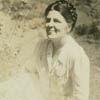Your shopping cart is empty!
Select currency
MENU

Clare Veronica Hope Leighton was born in London, the second of three children, to Robert Leighton and Marie Conner. Both her parents were writers, but each encouraged the early interest Clare Leighton showed in painting. In her teens the family moved to Keymer in Sussex and Leighton attended classes at Brighton College of Art before studying painting under Sir Henry Tonks at the Slade School of Fine Art, London (1922-3).
Clare Leighton found her métier, however, when soon after classes at the Slade she attended Noel Rooke's wood-engraving course at the Central School of Arts and Crafts. She was attracted by the range of effects which could be achieved through this medium, and whilst she would later write a number of books, experiment with oil painting and at the end of her life work with stained glass, it is essentially as a wood-engraver for which Leighton is now best known.
After her studies Clare Leighton travelled to France, Italy and to the Balkans where she sketched landscapes and peasant workers, and where she found the content on which she would most often concentrate. She felt an affinity for the rural worker, and she suggests in one of her later books that 'the true character of a people is to be found in its workers'*. She felt both a politically informed affinity, but a kind of aesthetic affinity, too, which often allows her to portray the worker's task as if it were itself a sort of craft. These two aspects, the political and the aesthetic, account for dual strands within Clare Leighton's work: she is realistic in her portrayals of the hardships of the worker's life, yet she delights all the same in the honest beauty of the worker's task.
Clare Leighton formed a relationship with the left-wing journalist Henry Noel Brailford and moved with him to a home, 'Four Hedges', in Monks Risborough, Buckinghamshire. Here she illustrated and wrote her three major books: 'The Farmer's Year' (1933) a chronicle through twelve months of life on the land; 'Four Hedges' (1935) a personal account of a year in the garden of her own home; and 'Country Matters' (1937) a celebration of English rural life on the eve of the Second World War.
In 1939 Clare Leighton travelled to the United States. She settled first in Chapel Hill, North Carolina, from where she undertook a teaching post at Duke University before moving to Woodbury, Connecticut (1951). She obtained book illustrating commissions including one for the works of Henry David Thoreau (1961), but during the later years of her life she turned from wood engraving to stained glass, creating designs for the transept windows of St. Paul's Cathedral, Worcester (1962). She died, unmarried, in November 1989 and is buried in Waterbury cemetery, Connecticut, having achieved as wide an acclaim in her adoptive country of the United States as she had already achieved in England, the country of her birth.
Clare Leighton's work, at least in terms of its sincerity and gravity of feeling, has sometimes been compared to Samuel Palmer's. And in these qualities there is a similarity: both artists evince a depth of love and appreciation for the land and for those who work the land. But Palmer's wood engravings are more condensed in form and composition. What Eric Gill writes of Bewick and Raverat, he might also have written of Palmer: each artist did 'little engravings that are big in spirit'. Writing about Clare Leighton more directly Gill finds something additional: 'no one in our time', he suggests, 'has succeeded better than Clare Leighton in penetrating the breath of the life of the earth on a scale so grand'*.
*1. 'Southern Harvest', Clare Leighton, English edition published by Gollancz (1943).
*2. Eric Gill in Gollancz's publicity leaflet for 'The Farmer's Year' (1933).
British Museum, London; Ashmolean Museum, Oxford; Boston Fine Arts; Boston, etc. A complete range of the twelve 'Farmer's Year' prints (of which we publish six) can at present be found in the dining-room of the British Ambassador's residence in Washington D. C.
This is a Limited Edition Giclee Print by the artist Clare Leighton 236mm x 280mm ..
£82.00 Ex Tax: £68.33
This is a Limited Edition Giclee Print by the artist Clare Leighton 223mm x 300mm ..
£82.00 Ex Tax: £68.33
This is a Limited Edition Giclee Print by the artist Clare Leighton 225mm x 288mm ..
£82.00 Ex Tax: £68.33
This is a Limited Edition Giclee Print by the artist Clare Leighton 223mm x 280mm ..
£82.00 Ex Tax: £68.33
This is a Limited Edition Giclee Print by the artist Clare Leighton 224mm x 293mm ..
£82.00 Ex Tax: £68.33
This is a Limited Edition Giclee Print by the artist Clare Leighton 223mm x 280mm ..
£82.00 Ex Tax: £68.33
This is a Limited Edition Giclee Print by the artist Clare Leighton 223mm x 280mm ..
£82.00 Ex Tax: £68.33
This is a Limited Edition Giclee Print by the artist Clare Leighton 225mm x 295mm ..
£82.00 Ex Tax: £68.33
This is a Limited Edition Giclee Print by the artist Clare Leighton 214mm x 284mm ..
£82.00 Ex Tax: £68.33
This is a Limited Edition Giclee Print by the artist Clare Leighton 238mm x 280mm ..
£82.00 Ex Tax: £68.33
This is a Limited Edition Giclee Print by the artist Clare Leighton 222mm x 264mm ..
£82.00 Ex Tax: £68.33
This is a Limited Edition Giclee Print by the artist Clare Leighton 240mm x 307mm ..
£82.00 Ex Tax: £68.33